Portal:Jazz/Selected biography/Archive
historical reference. . Either the page is no longer relevant or consensus on its purpose has become unclear. To revive discussion, seek broader input via a forum such as the village pump |
This page displays all the articles which have appeared in the "selected biography" section of the
1
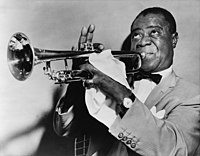
Louis Armstrong (August 4, 1901 – July 6, 1971), or Pops, was an American jazz trumpeter, singer, and an influential figure in jazz music.
Coming to prominence in the 1920s as an "inventive" trumpet and cornet player, Armstrong was a foundational influence in jazz, shifting the focus of the music from collective improvisation to solo performance. With his instantly recognizable gravelly voice, Armstrong was also an influential singer, demonstrating great dexterity as an improviser, bending the lyrics and melody of a song for expressive purposes. He was also skilled at scat singing (vocalizing using sounds and syllables instead of actual lyrics).
Renowned for his charismatic stage presence and voice almost as much as for his trumpet-playing, Armstrong's influence extends well beyond jazz music, and by the end of his career in the 1960s, he was widely regarded as a profound influence on popular music in general. Armstrong was one of the first truly popular African-American entertainers to "cross over", whose skin color was secondary to his music in an America that was severely racially divided. He rarely publicly politicized his race, often to the dismay of fellow African-Americans, but took a well-publicized stand for
2
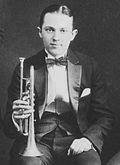
Leon Bismark "Bix" Beiderbecke (March 10, 1903 – August 6, 1931) was an American jazz cornetist, jazz pianist, and composer.
With Louis Armstrong and Muggsy Spanier, Beiderbecke was one of the most influential jazz soloists of the 1920s. His turns on "Singin' the Blues" and "I'm Coming, Virginia" (both 1927), in particular, demonstrated an unusual purity of tone and a gift for improvisation. With these two recordings, especially, he helped to invent the jazz ballad style and hinted at what, in the 1950s, would become cool jazz. "In a Mist" (1927), one of a handful of his piano compositions and one of only two he recorded, mixed classical (Impressionist) influences with jazz syncopation.
A native of
3
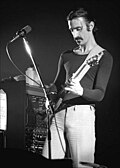
Frank Vincent Zappa (December 21, 1940 – December 4, 1993) was an American musician, bandleader, songwriter, composer, recording engineer, record producer, and film director. In a career spanning more than 30 years, Zappa composed rock, jazz, orchestral and musique concrète works. He also directed feature-length films and music videos, and designed album covers. Zappa produced almost all of the more than 60 albums he released with the band The Mothers of Invention and as a solo artist. While in his teens, he acquired a taste for 20th-century classical composers such as Edgard Varèse, Igor Stravinsky, and Anton Webern, along with 1950s rhythm and blues music. He began writing classical music in high school, while at the same time playing drums in rhythm and blues bands; he later switched to electric guitar.
Zappa was a self-taught composer and performer, and his diverse musical influences led him to create music that was often difficult to categorize. His 1966 debut album with the Mothers of Invention, Freak Out!, combined songs in conventional rock and roll format with collective improvisations and studio-generated sound collages. His later albums shared this eclectic and experimental approach, irrespective of whether the fundamental format was rock, jazz or classical. His lyrics—often humorously—reflected his iconoclastic view of established social and political processes, structures and movements. He was a strident critic of mainstream education and organized religion, and a forthright and passionate advocate for freedom of speech, self-education, political participation and the abolition of censorship. (Full article...)
4

As Farmer's reputation grew, he expanded from bebop into more experimental forms through working with composers such as George Russell and Teddy Charles. He went on to join Gerry Mulligan's quartet and, with Benny Golson, to co-found the Jazztet. Continuing to develop his own sound, Farmer switched from trumpet to the warmer flugelhorn in the early 1960s, and he helped to establish the flugelhorn as a soloist's instrument in jazz. He settled in Europe in 1968 and continued to tour internationally until his death. Farmer recorded more than 50 albums under his own name, a dozen with the Jazztet, and dozens more with other leaders. His playing is known for its individuality – most noticeably, its lyricism, warmth of tone and sensitivity. (Full article...)
5
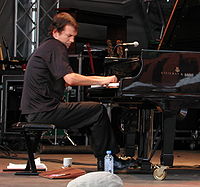
Bradford Alexander "Brad" Mehldau (/ˈmɛlˌdaʊ/; born August 23, 1970) is an American jazz pianist, composer, and arranger.
Mehldau studied music at The New School, and toured and recorded while still a student. He was a member of saxophonist Joshua Redman's Quartet with bassist Christian McBride and drummer Brian Blade in the mid-1990s, and has led his own trio since at least 1992. His first long-term trio featured bassist Larry Grenadier and drummer Jorge Rossy; in 2005 Jeff Ballard replaced Rossy. These bands have released a dozen albums under the pianist's name.
Since the early 2000s Mehldau has experimented with other musical formats in addition to trio and solo piano. Largo, released in 2002, contains electronics and input from rock and classical musicians; later examples include touring and recording with guitarist Pat Metheny, writing and playing song cycles for classical singers Renée Fleming and Anne Sofie von Otter, composing orchestral pieces for 2009's Highway Rider, and playing electronic keyboard instruments in a duo with drummer Mark Guiliana.
Aspects of pop, rock, and classical music, including German Romanticism, have been absorbed into Mehldau's writing and playing. Through his use of some traditional elements of jazz without being restricted by them, simultaneous playing of different melodies in separate hands, and incorporation of pop and rock pieces, Mehldau has influenced musicians in and beyond jazz in their approaches to writing, playing, and choice of repertoire. (Full article...)
6

Ketevan "Katie" Melua (/ˈmɛluːə/; Georgian: ქეთევან "ქეთი" მელუა [mɛluɑ]; born 16 September 1984) is a Georgian-British singer, songwriter and musician. She moved to Northern Ireland at the age of eight and then to England at fourteen. Melua is signed to the small Dramatico record label, under the management of composer Mike Batt, and made her musical debut in 2003. In 2006, she was the United Kingdom's best-selling female artist and Europe's highest selling European female artist. (Full article...)
7
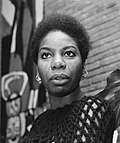
Nina Simone /ˈniːnə sɪˈmoʊn/ (born Eunice Kathleen Waymon; February 21, 1933 – April 21, 2003) was an American singer, songwriter, pianist, arranger, and civil rights activist widely associated with jazz music. She worked in a broad range of styles including classical, jazz, blues, folk, R&B, gospel, and pop.
The sixth child of a preacher's family in North Carolina, Simone aspired to be a concert pianist. Her musical path changed direction after she was denied a scholarship to the prestigious Curtis Institute of Music in Philadelphia, despite a well-received audition. Simone was later told by someone working at Curtis that she was rejected because she was black. So as to fund her continuing musical education and become a classical pianist, she began playing in a small club in Philadelphia where she was also required to sing. She was approached for a recording by Bethlehem Records, and her rendering of "I Loves You, Porgy" was a hit in the United States in 1958. Over the length of her career Simone recorded more than 40 albums, mostly between 1958, when she made her debut with Little Girl Blue, and 1974. (Full article...)
8

9

Anthony Dominick "Tony" Benedetto (born August 3, 1926), known as Tony Bennett, is an American singer of traditional pop standards, show tunes, and jazz. Bennett is also an accomplished painter, having created works—under the name Anthony Benedetto—that are on permanent public display in several institutions. He is the founder of the Frank Sinatra School of the Arts in New York City.
Raised in New York City, Bennett began singing at an early age. He fought in the final stages of
Bennett staged a comeback in the late 1980s and 1990s, putting out
10

Arthur "Art" Tatum, Jr. (/ˈteɪtəm/, October 13, 1909 – November 5, 1956) was an American jazz pianist.
Tatum is widely acknowledged as a virtuoso and one of the greatest jazz pianists of all time, and was a major influence on later generations of jazz pianists. He was hailed for the technical proficiency of his performances, which set a new standard for jazz piano virtuosity. Critic Scott Yanow wrote, "Tatum's quick reflexes and boundless imagination kept his improvisations filled with fresh (and sometimes futuristic) ideas that put him way ahead of his contemporaries." (Full article...)
11

In the mid-1930s, Benny Goodman led one of the most popular musical groups in America. His January 16, 1938 concert at Carnegie Hall in New York City is described by critic Bruce Eder as "the single most important jazz or popular music concert in history: jazz's 'coming out' party to the world of 'respectable' music."
Goodman's bands launched the careers of many major names in jazz. During an era of segregation he also led one of the first well-known integrated jazz groups. Goodman continued to perform to nearly the end of his life, while exploring an interest in classical music. (Full article...)
12
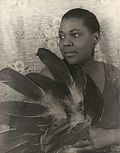
Nicknamed The Empress of the Blues, Smith was the most popular female blues singer of the 1920s and 1930s. She is often regarded as one of the greatest singers of her era and, along with Louis Armstrong, a major influence on other jazz vocalists.
Smith began forming her own act around 1913, at Atlanta's "81" Theater. By 1920, Smith had established a reputation in the
13
William John Evans, known as
14

Billie Holiday (born Eleanora Fagan; April 7, 1915 – July 17, 1959) was an American jazz singer and songwriter. Nicknamed "Lady Day" by her friend and musical partner Lester Young, Holiday had a seminal influence on jazz and pop singing. Her vocal style, strongly inspired by jazz instrumentalists, pioneered a new way of manipulating phrasing and tempo.
Holiday was signed to Brunswick Records by John Hammond to record current pop tunes with Teddy Wilson in the new "swing" style for the growing jukebox trade. They were given free rein to improvise the material. Holiday's improvisation of the melody line to fit the emotion was revolutionary. (Full article...)
15

Parker was a highly influential jazz soloist and a leading figure in the development of
Parker acquired the nickname "Yardbird" early in his career; this and its shortened form, "Bird", which continued to be used for the rest of his life, inspired the titles of a number of Parker compositions, such as "
Parker was an icon for the hipster subculture and later the Beat Generation, personifying the jazz musician as an uncompromising artist and intellectual rather than just an entertainer. (Full article...)
16
His compositions and improvisations feature
He was renowned for his distinctive style in suits, hats, and sunglasses. He was also noted for an idiosyncratic habit observed at times during performances: while the other musicians in the band continued playing, he would stop, stand up from the keyboard, and dance for a few moments before returning to the piano.
Monk is one of five jazz musicians to have been featured on the cover of
17

William James "Count" Basie (August 21, 1904 – April 26, 1984) was an American jazz pianist, organist, bandleader, and composer. His mother taught him to play the piano and he started performing in his teens. Dropping out of school, he learned to operate lights for vaudeville and to improvise accompaniment for silent films at a local movie theater in his home town of Red Bank, New Jersey. By 16, he increasingly played jazz piano at parties, resorts and other venues. In 1924, he went to Harlem, where his performing career expanded; he toured with groups to the major jazz cities of Chicago, St. Louis and Kansas City. In 1929 he joined Bennie Moten's band in Kansas City, and played with them until Moten's death in 1935.
That year Basie formed his own
18

John Birks "Dizzy" Gillespie (/ɡɪˈlɛspi/; October 21, 1917 – January 6, 1993) was an American jazz trumpeter, bandleader, composer and occasional singer.
Gillespie was a trumpet virtuoso and improviser, building on the virtuoso style of Roy Eldridge but adding layers of harmonic complexity previously unknown in jazz. He was an early player of bebop. (Full article...)
19

Jean-Baptiste "Django" Reinhardt (French: [dʒãŋɡo ʁɛjnaʁt] or [dʒɑ̃ɡo ʁenɑʁt]; 23 January 1910 – 16 May 1953) was a French guitarist and composer of Romani heritage.
Reinhardt is often regarded as one of the greatest guitar players of all time and was the first important European jazz musician who made major contributions to the development of the genre. After his third and fourth fingers were paralyzed when he suffered burns in a fire, Reinhardt used only the index and middle fingers of his left hand on his solos and invented an entirely new style of jazz guitar technique (sometimes called 'hot' jazz guitar) that has since become a
20

Edward Kennedy "Duke" Ellington (April 29, 1899 – May 24, 1974) was an American composer, pianist and bandleader of jazz orchestras. He led his orchestra from 1923 until his death, his career spanning over 50 years.
Born in Washington, D.C., Ellington was based in New York City from the mid-1920s onward, and gained a national profile through his orchestra's appearances at the Cotton Club. In the 1930s, his orchestra toured in Europe. Though widely considered to have been a pivotal figure in the history of jazz, Ellington himself embraced the phrase "beyond category" as a "liberating principle", and referred his music to the more general category of "American Music", rather than to a musical genre such as "jazz".
Some of the musicians who were members of Ellington's orchestra, such as saxophonist
21

Sarah Lois Vaughan (March 27, 1924 – April 3, 1990) was an American jazz singer, described by music critic Scott Yanow as having "one of the most wondrous voices of the 20th century."
Nicknamed "Sassy", "
Vaughan began her solo career in 1945 by freelancing in clubs on New York's
22

Gerald Joseph "Gerry" Mulligan (April 6, 1927 – January 20, 1996) was an American jazz saxophonist, clarinetist, composer and arranger. Though Mulligan is primarily known as one of the leading baritone saxophonists in jazz history – playing the instrument with a light and airy tone in the era of cool jazz – he was also a notable arranger, working with Claude Thornhill, Miles Davis, Stan Kenton, and others. Mulligan's pianoless quartet of the early 1950s with trumpeter Chet Baker is still regarded as one of the more important cool jazz groups. Mulligan was also a skilled pianist and played several other reed instruments. (Full article...)
23
He began his recording career in the late 1960s, featuring on recordings by the American jazz composer
24
Widely recognized as a pivotal figure in early
25
As his career progressed, Coltrane and his music took on an increasingly spiritual dimension. His second wife was pianist Alice Coltrane and their son Ravi Coltrane is also a saxophonist. Coltrane influenced innumerable musicians, and remains one of the most significant saxophonists in music history. He received many posthumous awards and recognitions, including canonization by the African Orthodox Church as Saint John William Coltrane and a special Pulitzer Prize in 2007. (Full article...)
26
27
Coming to prominence while a member of Count Basie's orchestra, Young was one of the most influential players on his instrument. In contrast to many of his hard-driving peers, Young played with a relaxed, cool tone and used sophisticated harmonies, using "a free-floating style, wheeling and diving like a gull, banking with low, funky riffs that pleased dancers and listeners alike".
Known for his hip, introverted style, he invented or popularized much of the hipster jargon which came to be associated with the music. (Full article...)
28

Louis Armstrong (August 4, 1901 – July 6, 1971), or Pops, was an American jazz trumpeter, singer, and an influential figure in jazz music.
Coming to prominence in the 1920s as an "inventive" trumpet and cornet player, Armstrong was a foundational influence in jazz, shifting the focus of the music from collective improvisation to solo performance. With his instantly recognizable gravelly voice, Armstrong was also an influential singer, demonstrating great dexterity as an improviser, bending the lyrics and melody of a song for expressive purposes. He was also skilled at scat singing (vocalizing using sounds and syllables instead of actual lyrics).
Renowned for his charismatic stage presence and voice almost as much as for his trumpet-playing, Armstrong's influence extends well beyond jazz music, and by the end of his career in the 1960s, he was widely regarded as a profound influence on popular music in general. Armstrong was one of the first truly popular African-American entertainers to "cross over", whose skin color was secondary to his music in an America that was severely racially divided. He rarely publicly politicized his race, often to the dismay of fellow African-Americans, but took a well-publicized stand for
